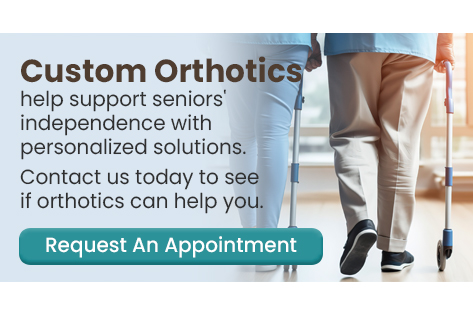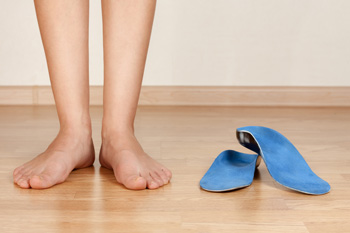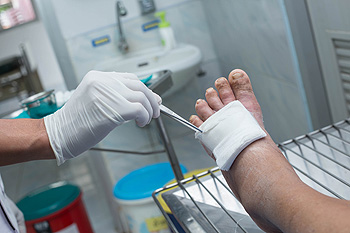Items filtered by date: February 2024
Foot and Ankle Injuries From Volleyball

Volleyball is a popular sport worldwide. Players of all ages and skill levels can enjoy the game, with many competing at the international level. Due to the physical demands of volleyball, players can experience various injuries, both acute and overuse. Common acute injuries in volleyball are ankle sprains, often caused during jumps from blocking or spiking. Overuse injuries include patellar tendinitis, or jumper's knee, and patellofemoral syndrome, resulting from repetitive jumping and landing. Managing these injuries involves cold therapy, anti-inflammatory medication, and exercises to strengthen and stabilize the affected areas. Achilles tendinitis is another common overuse injury, particularly among indoor players, caused by repetitive jumping on hard surfaces. Peroneal tendinitis may occur in players with high arches due to frequent dorsiflexion and eversion movements. Plantar fasciitis is common due to repetitive jumping and inadequate arch support. Prevention involves stretching, conditioning, proper technique, and pronation control. Furthermore, hyperextension and hyperflexion injuries, such as turf toe or toe folding, can occur. Taping, wearing appropriate footwear, and orthoses may help to prevent and treat these injuries. If you play volleyball and have incurred a foot or ankle injury, it is suggested that you schedule an appointment with a podiatrist for a proper diagnosis and treatment so you can get back to your game as soon as possible.
Sports related foot and ankle injuries require proper treatment before players can go back to their regular routines. For more information, contact one of our podiatrists of Ankle & Foot of Edmonds. Our doctors can provide the care you need to keep you pain-free and on your feet.
Sports Related Foot and Ankle Injuries
Foot and ankle injuries are a common occurrence when it comes to athletes of any sport. While many athletes dismiss the initial aches and pains, the truth is that ignoring potential foot and ankle injuries can lead to serious problems. As athletes continue to place pressure and strain the area further, a mild injury can turn into something as serious as a rupture and may lead to a permanent disability. There are many factors that contribute to sports related foot and ankle injuries, which include failure to warm up properly, not providing support or wearing bad footwear. Common injuries and conditions athletes face, including:
- Plantar Fasciitis
- Plantar Fasciosis
- Achilles Tendinitis
- Achilles Tendon Rupture
- Ankle Sprains
Sports related injuries are commonly treated using the RICE method. This includes rest, applying ice to the injured area, compression and elevating the ankle. More serious sprains and injuries may require surgery, which could include arthroscopic and reconstructive surgery. Rehabilitation and therapy may also be required in order to get any recovering athlete to become fully functional again. Any unusual aches and pains an athlete sustains must be evaluated by a licensed, reputable medical professional.
If you have any questions please feel free to contact our office located in Edmonds, WA . We offer the newest diagnostic and treatment technologies for all your foot and ankle needs.
Proper Width of Shoes

Properly fitting shoes are essential for foot health, considering that your feet can take thousands of steps daily. Shoe width is equally important as shoe length and can greatly affect your comfort and overall well-being. Shoe width is typically measured around the forefoot, which is the widest part of your foot. However, not all shoe brands offer a variety of widths, making it challenging to find options narrower or wider than the standard. It is important to have your feet measured each time you shop for shoes since your feet can change shape and size over time. Measuring at day's end, when your feet are at their largest, helps ensure you do not underestimate the width. Most people have one foot larger than the other, so choose shoes based on the size of your larger foot. Shoes should fit comfortably from the start, as trying to break in footwear that is too tight can lead to foot problems and pain. In fact, wearing tight shoes can cause common foot issues like corns, calluses, ingrown toenails, bunions, and hammer toes, which can be painful and may require treatment, including surgery in severe cases. If persistent foot pain, toe deformities, signs of infection, or underlying health issues such as diabetes or poor blood flow are a concern, it is suggested that you consult a podiatrist for appropriate guidance in selecting the proper width shoes for your feet.
Getting the right shoe size is an important part of proper foot health. Seek the assistance of one of our podiatrists from Ankle & Foot of Edmonds. Our doctors will provide the care you need to keep you pain-free and on your feet.
Getting the Right Shoe Size
There are many people who wear shoes that are the incorrect size, negatively affecting their feet and posture. Selecting the right shoes is not a difficult process, so long as you keep several things in mind when it comes to choosing the right pair.
- When visiting the shoe store, use the tools available to measure your foot.
- Be sure there is ‘wiggle room’. There should be about an inch between your toes and the tip of your shoes.
- Do not always assume you are the same size, as manufacturers run differently.
- Purchase shoes later in the day, as your feet swell as the day progresses.
- If a shoe is not comfortable, it is not suitable. Most shoes can’t be ‘broken in’, and comfort should be the ultimate goal when it comes to choosing the right pair of shoes
As our feet hold our body weight and keep us moving, it is important to treat them right. Picking the right pair of shoes can provide your feet comfort and mobility without pain.
If you have any questions, please feel free to contact our office located in Edmonds, WA . We offer the newest diagnostic and treatment technologies for all your foot care needs.
Custom Orthotics For Seniors

Age gracefully and move freely with Custom Orthotics. For seniors seeking to maintain their independence, Custom Orthotics offer the stability and comfort essential for daily activities. Custom-tailored to your feet, they provide support, reduce pain, and enhance mobility, ensuring you're always on sure footing. Don't let age-related foot concerns hold you back. With Custom Orthotics, embrace every golden moment with confidence. Call today to schedule an appointment.
Causes and Definition of Ingrown Toenails

Ingrown toenails, a common ailment, occur when the edge of a toenail grows into the surrounding skin, leading to discomfort and potential complications. The causes often stem from improper nail trimming, tight footwear, or inherited nail shape, creating an environment conducive to ingrowth. The condition typically manifests as redness, swelling, and pain along the nail's edge. Diagnosis involves a careful examination by a podiatrist who assesses the visual symptoms and inquires about the individual's lifestyle and footwear choices. While mild cases may be managed with warm soaks and proper nail care, severe instances may require medical intervention. Podiatrists may recommend partial nail removal or antibiotics to address infection. An ingrown toenail can cause severe pain and discomfort. If you have developed this condition, it is suggested that you consult a podiatrist who can provide the treatment that is right for you.
Ingrown toenails may initially present themselves as a minor discomfort, but they may progress into an infection in the skin without proper treatment. For more information about ingrown toenails, contact one of our podiatrists of Ankle & Foot of Edmonds. Our doctors can provide the care you need to keep you pain-free and on your feet.
Ingrown Toenails
Ingrown toenails are caused when the corner or side of a toenail grows into the soft flesh surrounding it. They often result in redness, swelling, pain, and in some cases, infection. This condition typically affects the big toe and may recur if it is not treated properly.
Causes
- Improper toenail trimming
- Genetics
- Improper shoe fitting
- Injury from pedicures or nail picking
- Abnormal gait
- Poor hygiene
You are more likely to develop an ingrown toenail if you are obese, have diabetes, arthritis, or have any fungal infection in your nails. Additionally, people who have foot or toe deformities are at a higher risk of developing an ingrown toenail.
Symptoms
Some symptoms of ingrown toenails are redness, swelling, and pain. In rare cases, there may be a yellowish drainage coming from the nail.
Treatment
Ignoring an ingrown toenail can have serious complications. Infections of the nail border can progress to a deeper soft-tissue infection, which can then turn into a bone infection. You should always speak with your podiatrist if you suspect you have an ingrown toenail, especially if you have diabetes or poor circulation.
If you have any questions, please feel free to contact our office located in Edmonds, WA . We offer the newest diagnostic and treatment technologies for all your foot care needs.
Gout Pain Can Be Managed
Custom Orthotics for Special Needs Patients

Orthotics play a vital role in addressing the unique requirements of special needs patients, offering tailored solutions for various musculoskeletal issues. These individuals often require specialized orthotic devices to enhance their mobility and overall quality of life. Custom orthotics are designed to accommodate or correct irregular walking patterns, providing crucial support and stability. For special needs patients, orthotics can help manage conditions such as flat feet, high arches, and gait abnormalities. These devices are customized to fit the individual's unique foot shape and condition, ensuring optimal comfort and functionality. Whether it is children with developmental challenges or adults with neurological disorders, orthotics can significantly improve their mobility and reduce discomfort. Orthotic devices for special needs patients are prescribed by podiatrists after a thorough evaluation and diagnosis, ensuring that they cater to the specific challenges of each patient. If you have special needs or you are taking care of someone with special needs and want more information on how custom orthotics might improve comfort, it is suggested that you make an appointment with a podiatrist to discuss your unique situation.
If you’re experiencing foot discomfort, have a history of foot and ankle injuries, or are interested in exploring Custom orthotics, don’t hesitate to contact one of our podiatrists at Ankle & Foot of Edmonds. Our doctors is dedicated to offering the care required to help you remain pain-free and stay on your feet.
What are Custom Orthotics?
Custom orthotics refer to custom inserts designed for placement in different shoe types, including athletic and formal footwear, with the purpose of alleviating a spectrum of foot-related problems such as flat feet, heel pain, and overall foot discomfort. These inserts are instrumental in providing relief and comfort for a diverse range of foot conditions, including heel pain, and can also act as a proactive approach to injury prevention.
Medical Grade Shoe Inserts:
A diverse array of shoe inserts is available for addressing foot pain, heel discomfort, and minor issues. For instance, you can place arch supports in your shoes to rectify overarched or flat feet, and gel and cushioned insoles are frequently chosen for the comfort and relief they provide from foot and heel pain by reducing pressure.
If you have any questions please contact our office located in Edmonds, WA . We offer the newest diagnostic and treatment technologies for all your foot and ankle needs.
Diabetic Ulcers and Wound Care

Diabetic foot ulcers are a severe problem for people with diabetes and can lead to serious health issues, such as amputations. To treat diabetic foot ulcers, podiatrists typically use methods like cleaning the wound, using special dressings, taking care of the patient's overall health, and checking blood vessels. There is ongoing research that explores additional treatments to speed up healing and reduce the need for amputations. These extra treatments include things like specific types of dressings, oxygen therapy, and growth factors. More research is needed to confirm their effectiveness. If you suffer from diabetic foot ulcers, it is strongly suggested that you are under the care of a podiatrist who can perform regular foot exams. Treating these types of ulcers as early as possible is essential to an easier healing process.
Wound care is an important part in dealing with diabetes. If you have diabetes and a foot wound or would like more information about wound care for diabetics, consult with one of our podiatrists from Ankle & Foot of Edmonds. Our doctors will assess your condition and provide you with quality foot and ankle treatment.
What Is Wound Care?
Wound care is the practice of taking proper care of a wound. This can range from the smallest to the largest of wounds. While everyone can benefit from proper wound care, it is much more important for diabetics. Diabetics often suffer from poor blood circulation which causes wounds to heal much slower than they would in a non-diabetic.
What Is the Importance of Wound Care?
While it may not seem apparent with small ulcers on the foot, for diabetics, any size ulcer can become infected. Diabetics often also suffer from neuropathy, or nerve loss. This means they might not even feel when they have an ulcer on their foot. If the wound becomes severely infected, amputation may be necessary. Therefore, it is of the upmost importance to properly care for any and all foot wounds.
How to Care for Wounds
The best way to care for foot wounds is to prevent them. For diabetics, this means daily inspections of the feet for any signs of abnormalities or ulcers. It is also recommended to see a podiatrist several times a year for a foot inspection. If you do have an ulcer, run the wound under water to clear dirt from the wound; then apply antibiotic ointment to the wound and cover with a bandage. Bandages should be changed daily and keeping pressure off the wound is smart. It is advised to see a podiatrist, who can keep an eye on it.
If you have any questions, please feel free to contact our office located in Edmonds, WA . We offer the newest diagnostic and treatment technologies for all your foot care needs.

